CARE AND MANAGEMENT
Pig Rearing
PREGNANT PIGS
- Avoid over-crowding, mixing of new and old stock, and slippery ground and over exciting of pregnant pigs.
- Calculate the expected farrowing date from the recorded breeding date. Provide a separate clean and dry sty with non-slippery floor.
- Provide well-balanced pregnancy ration for uniform litter and better birth weight.
- Provide good nutritious ration.
- Leguminous greens like Berseem, Lucerne and cowpea should be liberally fed. As major growth of the developing fetuses take place from 70-90 days of gestation so increase the amount of feed during this period.
- Avoid heat stress by providing plenty of fresh drinking water.
- Pregnant gilts/ sows should not be mixed with other animals to avoid fighting which may lead to skidding and abortions.
- Pregnant pigs should not be mixed with other diseased or aborted pigs. Don’t disturb or make them fatigue. Regular checkup with veterinarian should be done.
- Provide a bedding of 8-10 cm of chopped straw under the covered area.
- De-worm the pregnant females 2 weeks before farrowing with broad-spectrum anti-helminthics like Albendazole, Fenbendazole at the rate of 10 mg/kg body weight. Handle the animal gently while treatment.
- Sows should also be treated for external parasite prior to admitting into the farrowing pen (0.01-0.05% of Deltamethrin, permethrin or Amitraz).
- Before moving into the farrowing pen, the sow should be thoroughly scrubbed with soap and warm water especially in the region of the sides, udder, under surface of the body and inter-digital space to prevent diarrhoea.
- Trim the overgrown long toe of sow to minimize crushing injuries. Move the clean animal to the clean pen 10 days before farrowing.
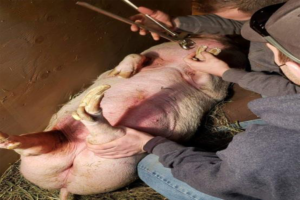
- Avoid over-crowding, mixing of new and old stock, and slippery ground and over exciting of pregnant pigs.
- Calculate the expected farrowing date from the recorded breeding date. Provide a separate clean and dry sty with non-slippery floor.
- Provide well-balanced pregnancy ration for uniform litter and better birth weight.
- Provide good nutritious ration.
- Leguminous greens like Berseem, Lucerne and cowpea should be liberally fed. As major growth of the developing fetuses take place from 70-90 days of gestation so increase the amount of feed during this period.
- Avoid heat stress by providing plenty of fresh drinking water.
- Pregnant gilts/ sows should not be mixed with other animals to avoid fighting which may lead to skidding and abortions.
- Pregnant pigs should not be mixed with other diseased or aborted pigs. Don’t disturb or make them fatigue. Regular checkup with veterinarian should be done.
- Provide a bedding of 8-10 cm of chopped straw under the covered area.
- De-worm the pregnant females 2 weeks before farrowing with broad-spectrum anti-helminthics like Albendazole, Fenbendazole at the rate of 10 mg/kg body weight. Handle the animal gently while treatment.
- Sows should also be treated for external parasite prior to admitting into the farrowing pen (0.01-0.05% of Deltamethrin, permethrin or Amitraz).
- Before moving into the farrowing pen, the sow should be thoroughly scrubbed with soap and warm water especially in the region of the sides, udder, under surface of the body and inter-digital space to prevent diarrhoea.
- Trim the overgrown long toe of sow to minimize crushing injuries. Move the clean animal to the clean pen 10 days before farrowing.

SOW AT FARROWING TIME
- Clean and disinfect the farrowing sheds and keep it vacant for a week. Cleaning should be done by scrapping, with high-pressure cleaners, steam cleaners and with stiff brushes.
- Arrange bedding. Make warm conditions. A light bulb of 60-100 watts should be installed in the room. Keeping the height of the bulb low, can provide warmth to piglets during winter. Generally pigs farrow at cooler parts of the day.
- Disinfect with commercially available disinfectants like quaternary ammonium compounds, iodoform compounds, lye or with phenolic compounds.
- Provide light bedding of chopped straw 2-3 days before farrowing. Reduce the ration by 1/3rd till farrowing. Provide bulky ration (refer farrowing ration).
- Withdraw feed 12 hours before farrowing. Provide access to fresh drinking water.
- Keep the sow comfortable at a temperature below 24°C and the farrowing pen should be dry, warm and clean and should offer protection from heat, cold and winds.
- Appearance of milk in teats when pressed indicates the approach of farrowing time.
SOW AFTER FARROWING
- Clean the sow with lukewarm water and allow her to lick her young ones. Observe the sow whether it is active because after farrowing mostly mothers will lose energy and can’t take care of their litter.
- Check whether placenta has fallen or not. Observe the temperature of the body. If the mother seems weak, provide jaggery. Clean the shed regularly.
- Provide sow her first meal 12 hours after farrowing. The sow may be fed the same bulky ration fed before farrowing. It is best to feed half of the ration on the first day and to increase the ration to 200 to 300g daily until she is full fed.
- Artificial brooding is another reason for heat stress to the sow; therefore provide cooler conditions for the sow.
- The udder and teats of sow should be dry and clean.
- The litter size should be equalized by moving piglets from large litters to small litters and cross fostering in order to make the litter size equal. This should be done during the first three days of farrowing.
- Generally the sow’s milk contains less iron which may lead to piglet anaemia. Care should be taken to prevent deficiency diseases. Swab the sow’s udder with a saturated solution of ferrous sulphate, zinc sulphate and copper sulphate or giving iron injections to piglets to prevent nutritional anaemia. Provide adequate nutritious balanced ration to the lactating sow for sufficient milk production.
- Problems faced during farrowing or after farrowing, may be cruelty or biting or killing its own litter. Sometimes, biting or killing the first piglet which comes to mother in search of milk can be observed. This cruelty can be observed in sows with more fat and in certain breeds. Savaging by pigs may be a reaction towards act of farrowing or due to different or new farrowing places. Sometimes keeping piglets in a warm litter box is needed till farrowing is completed. Presence of a person can avoid such situations.
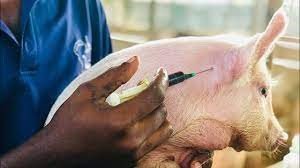
LACTATING SOWS
- During lactation the sow suffers heavy nutrient loss through milk. Nearly 180 to 185 kg milk is produced during a lactation period of 56 days. The peak yield is attained at 3 weeks. Hence up to one month of lactation nutrient rich diet is essential.
- Potable drinking water should be provided ad-libitum. ‘Split suckling’ or ‘split milk feeding’ can be adopted to level up piglets. It consists of splitting up the litter into two groups based on their size and allowing the lighter weight group first followed by the heavier ones.
GILTS AND SOWS
- Maturity of gilt is more important than its age. Skip the 1st heat and breed the gilts in their 2nd or 3rd heat to attain large litter size.
- Flushing should be carried out 2 to 3 weeks before breeding. Flush the gilts (feed liberally) to ensure a gain of about 500 g per day during 2 to 3 weeks before breeding.
- Heat period of sow lasts for 2 to 3 days. They should be bred on the 2nd day of heat (24 hours after the onset of heat symptoms. Preferably 2 services required at 8-12 hours interval. The females which are not conceived will come into heat at 21 days interval.
- The date of mating should be recorded from which the expected date of farrowing is calculated keeping in view the gestation period of 114 days.
- The breeding stock ration containing cereals and oil cakes well balanced with minerals and vitamins should be provided.
- Leguminous fodders like Berseem, Lucerne, Cowpea etc. should be freely made available.
- Gilts and sows for breeding should be maintained at a lower temperature of 16°C. The house should be clean with a controlled environmental condition to avoid stress.
- Gilts and sows should be dewormed 2 weeks before farrowing.
PIGLETS AT BIRTH


- Farrowing should be attended by an experienced person irrespective of the time of day or night. Remove the piglets soon after they are farrowed.
- Immediately after birth, clean and dry the piglets with rice straw or with clean gunny bag.
- Squeeze the nostrils and ensure breathing.
- If the piglets seem weak, then provide glucose water to drink.
- Clean all piglets free of mucous and make their body dry. The navel cord should be cut at a distance 2.5 cm from the body with a sterilized scissors, apply a cord clamp and disinfect with tincture iodine.
- Transfer the piglets to creep area in which temperature is 25 to 30°C to protect from chilling. Assist the piglets to get to the teat and suck colostrum from their mother’s udder.
- Ensure milk production from all teats and make sure all piglets get the colostrum.
- The sow should suckle the piglets 8 to 10 times initially in the 24 hours period. Following parturition, sow will often call her litter to suck by emitting repeated short grunts and may emit loud barking grunts if an intruder disturbs the nest.
- The sow rarely licks or grooms her young but sometimes appears to try to position the piglets near her udder or draw them towards her teats using her forelegs in scooping action.
- Protect baby pigs from aggressive sow and from trampling. Arranging iron bars called guard rails, prevent the crushing of piglets by mother.
- As soon as the afterbirth is expelled, it should be removed from the pen and burned or buried in lime. This prevents the sow from eating the after-birth. Remove wet, stained or soiled bedding and provide clean fresh material.
- Provide micro-environment of light and heat to keep piglets comfortable. The temperature regulatory mechanism is ill-developed in new-born piglets.
- Litter materials provide a temperature of 8°C more to the piglets, which is effective.
- Provide supplementary feeding in case of inadequate nourishing ability of sow. In such cases milk replacers can be fed using a soft plastic tube with a syringe attached.
SUCKLING PIGS
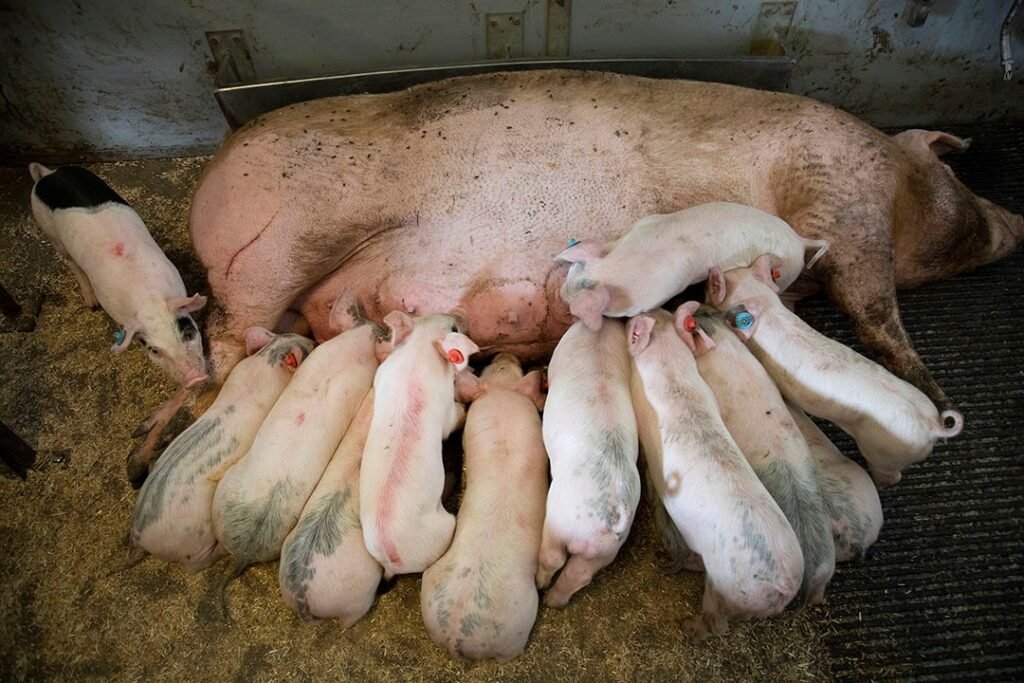

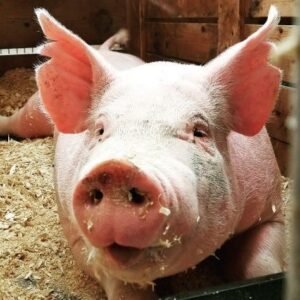
- Record birth weights of the piglets.
- Protect piglets from hypoglycemia. Due to this, piglets will always be weak, un-interested and becomes fatigue.
- Front teats are wider and produce more milk than back teats and make more accessible when lied down. Therefore, the piglets that suckle the front teat usually have a faster growth rate. Piglets establish their teat pattern soon after their birth and often take milk from the same teat until they are weaned. Small, weak piglets often suckle from the less productive rear teats, further reducing their chance of survival. Monitoring these piglets is important.
- Ensure that all piglets are getting their food and enough teats are available.
- The “needle” teeth should be clipped. New born pigs have four pairs of small, tusks like teeth called needle teeth or “wolf teeth”. They are of no practical value to the pigs themselves and these sharp teeth often cause pain or injury to the sow or other piglets. Therefore, it is advisable to clip these teeth shortly after birth within 1 to 3 days.
- The piglets should be identified immediately after birth by painting with silver nitrate solution and later by permanent identification methods like tattooing or ear notching.
- Management practices to prevent piglet anaemia should be adopted. Iron dextran injection should be given on the 4th and 14th day is an easy and practiced procedure.
- In totally confined commercial production system, docking of the tail is advisable to avoid the vice of tail biting. The tail should be cut as short as a stub as possible.
- Piglets start nibbling feed as early as one and a half weeks. Creep feed should be supplied during the second week to encourage dry feed consumption.
- By this time baby pigs develop appetite for dry feed as their feed requirement begins to exceed the nutrition supplied by the sow’s milk.
- Excess male piglets not required for breeding are generally castrated at 2-3 weeks of age.
- The final task to be performed on suckling pig is weaning. Depending on the management status of the herd, conventional weaning at 8 weeks or early weaning at 4 weeks or split weaning before 4 weeks can be adopted.
- Before weaning, mother should be separated for few hours every day. Increase this time period daily till the piglets are separated completely.
YOUNG STOCK
- Raise the piglets in small batches of 5 to 20 after weaning. Deworm when they are at 5 to 6 weeks old and repeat after one month.
- Ectoparasitic infestation should be removed by spraying with synthetic pyrethroids or giving doramectin injection.
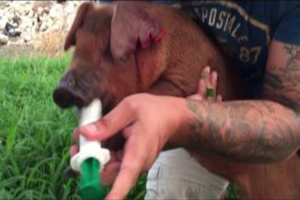
VACCINATION SCHEDULE OF SWINE
| Disease | Age |
| Swine fever | 3 to 6 weeks |
| Swine erysipelas | 2 months |
| FMD | 2 months |
| Brucellosis | 2 months |
| Swine influenza | At any stage |
Source: vaccines for veterinary application. Peters A.R(2006)
BOARS
- They should be fed after service rather than before. Outdoor exercise is good for keeping the boar thrifty and virile.
- Each boar should be housed separately and provided with 1.5 to 2.5 m of sleeping area.
- Optimum number of service for boar is 2-4 per week, depending on the age of the boar. For optimum performance do not use young boar for more than one service daily and matured boar for not more than 2 services a day.
- Boars of different ages should not be kept together. It can result in fatal fighting.
- In hot weather, boars need to be kept cool with shades, fogging or sprinkling, with a concrete hog wallow or evaporative cooling.
- Avoid slippery floors in the breeding areas.
Boars should be dewormed one week before breeding. Rotation of boars should be practised to avoid breeding depression. If new boars are brought to the herd, he should not be used for mating unless after a quarantine and isolation period of 30 days.
